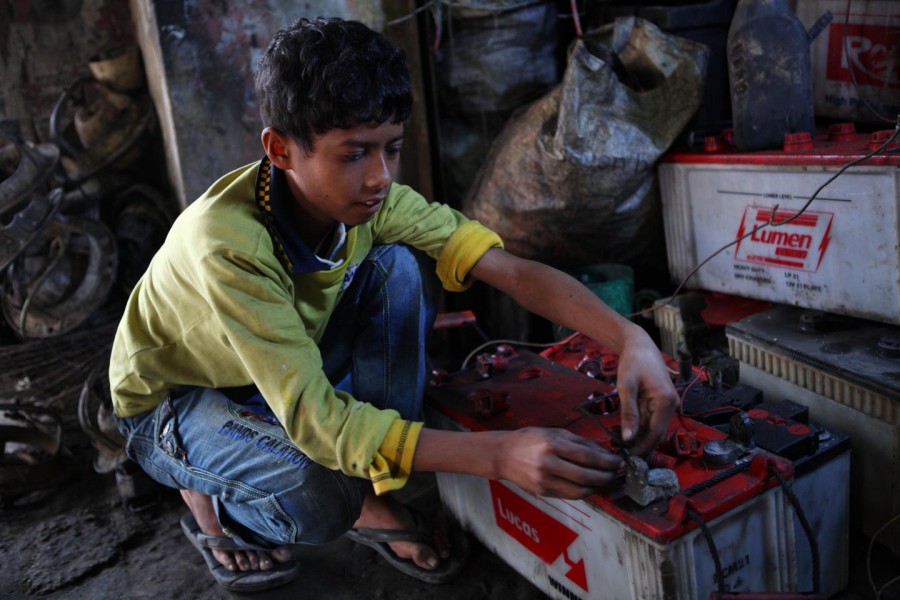Globally, Bangladesh is one of the fastest-growing economies in South Asia. Bangladesh has maintained an inspiring track record of growth and poverty reduction since last couple of decades, which is supported by a demographic dividend, increase in life expectancy, increased literacy, and many other indicators. With globalisation, Bangladesh is also facing challenges in tackling environmental pollution and related health challenges. Currently, Bangladeshi children are suffering from severe childhood lead exposures as confirmed by several epidemiological and biomedical researches. As per the Institute of Health Metric and Evaluation (IHME), Bangladesh is in the top tier of the most lead-impacted countries in the world. An estimated 36 million Bangladeshi children (approximately 60 per cent of the total) have alarming concentrations of lead in their blood (higher than 5 micrograms per deciliter). This higher level of lead in the blood has been recognized by the World Health Organisation (WHO) as an important cause of brain damage and IQ loss. The impacts from lead exposure can significantly affect the overall health status, societal wellbeing, and future economic prosperity of the Bangladeshi population and therefore require increased attention and investment on the part of the government, related industries, civil society, and the country's development partners.
Lead has been found to be harmful particularly to children. Childhood lead exposure can have life-altering consequences, including reduced neurological development resulting in permanently reduced intelligence, lower educational attainment, higher rates of juvenile delinquency and incarceration, and reduced lifetime earnings. The average concentration of lead in a child's blood in Bangladesh is estimated to be among the highest in the world which is approximately 7.5 micrograms per deciliter (?g/dL). At this high level, it would be reasonable to anticipate significant intelligence quotient (IQ) reductions over the time amongst the tens of millions of chronically exposed Bangladeshi children. According to IHME, in 2019, lead exposures resulted in more than 38,000 deaths (3.6 per cent of all deaths) and the loss of 690,000 years of healthy life in Bangladesh. Today, the death rate attributable to lead exposures in Bangladesh exceeds the death rate from unsafe water-borne diseases and air pollution. Low levels of lead affect children's IQ, their ability to pay attention, and how well they perform in school. Pervasive childhood lead exposure not only causes negative health outcomes but also inhibits economic growth as they are less likely to contribute to society in comparison to similarly aged youths. All these factors also lead to increased healthcare expenditure; therefore a major opportunity cost can be addressed for this preventable condition. Preventive measures can contribute to the overall economic development, which is a critical need for the country. According to a conservative estimate of the World Health Organisation (WHO), the decrease in intelligence attributable to each 1 µg/dl increase in blood lead level is 0.25 IQ points, and the decrement in lifetime economic productivity associated with each lost IQ point is 2.4 per cent. Using this "conservative estimate," and an average childhood blood lead level of 7.5 micrograms per deciliter, Bangladesh may currently face a population-wide decrease in economic productivity of 4.5 per cent annually. Bangladesh loses US $15.9 billion in GDP from productivity losses resulting from reduced IQ from lead exposures. This economic loss does not include lost earnings from lead-attributable diseases, healthcare costs, lost earnings from premature death, lost tax revenue from illegal used lead-acid battery (ULAB) recycling operations, or other economic impacts. The World Health Organization has concluded that the economic benefits of interventions to prevent lead exposure vastly outweigh their costs. Therefore, this economic loss from lead exposures is staggering which needs attention.
As described in "8th Five Year Plan July 2020 - June 2025: Promoting Prosperity and Fostering Inclusiveness" (8FYP), Bangladesh's desire is to achieve upper-middle-income status by 2031. To achieve the target, the General Economic Division (GED) of the Government of Bangladesh has laid out many ambitious targets which relate to poverty reduction, income inequality, employment opportunity, education, public health, and ultimately overall economic growth of the country. The best available data suggest that these goals are currently being undermined by various impediments including widespread childhood lead poisoning, and therefore addressing the lead poisoning concern could advance a variety of our priorities. Given the extraordinary health and economic toll from lead exposures in Bangladesh, a sustained, coordinated, national risk-reduction strategy is indispensable.
Dr Mahfuzar Rahman is the Country Director of Pure Earth Bangladesh
He can be reached at [email protected]


